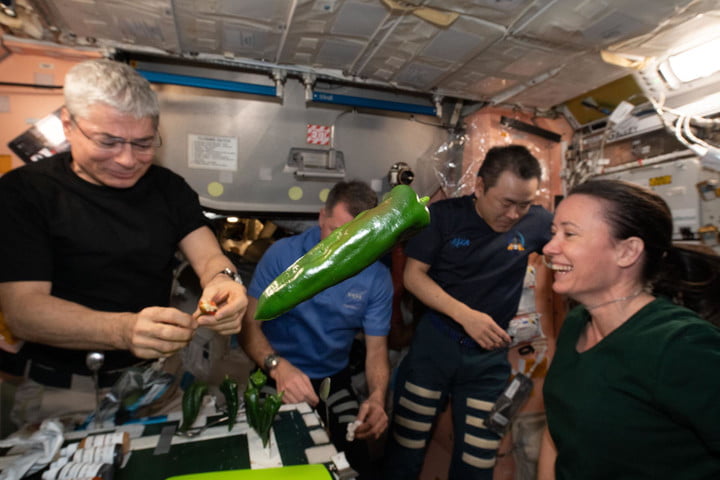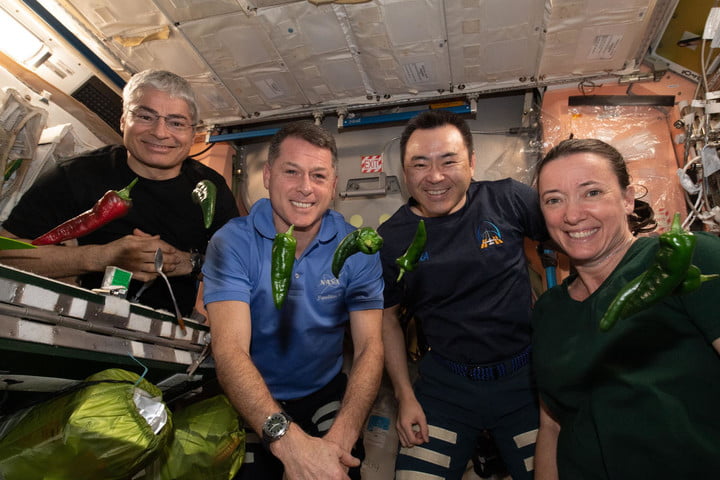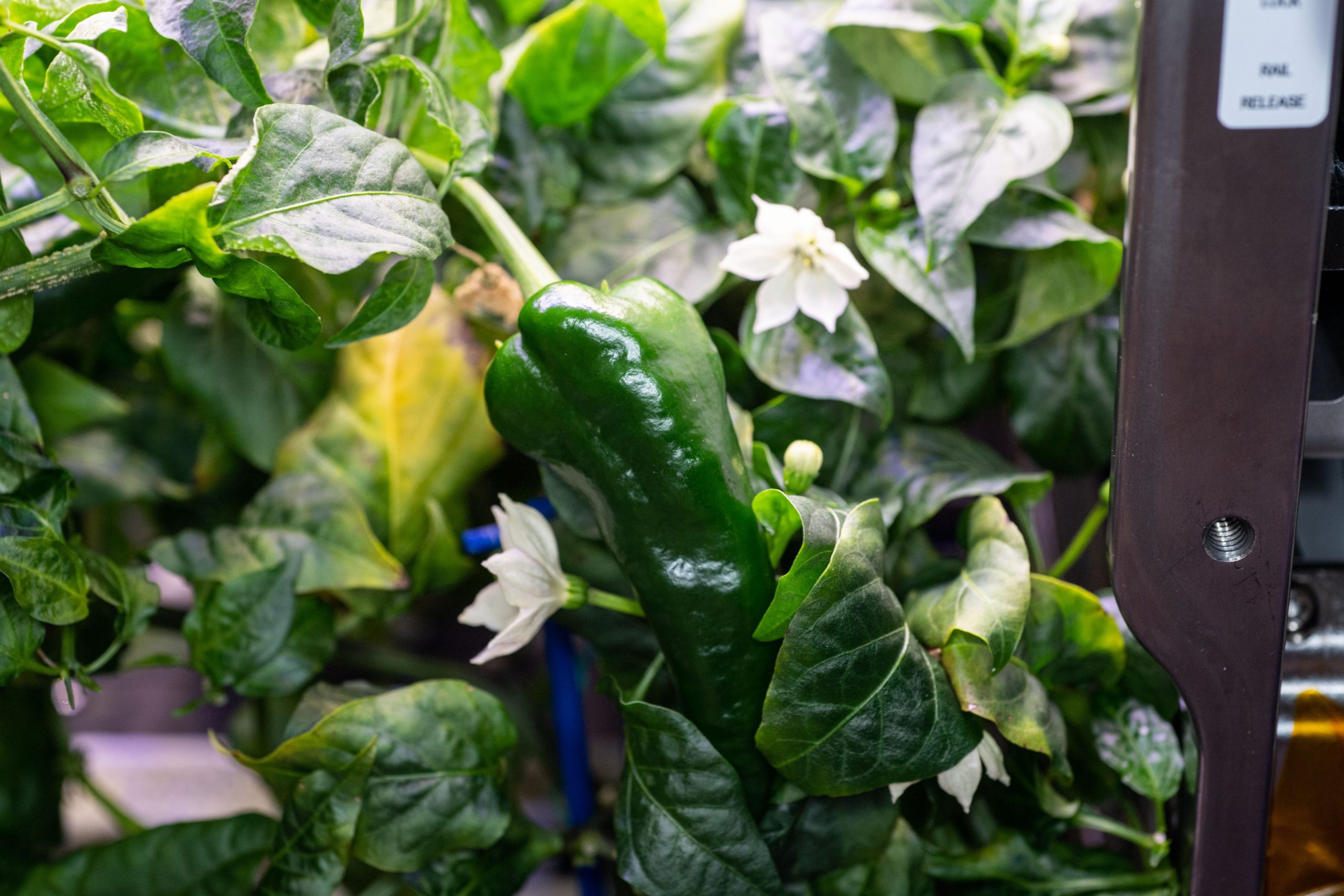A few weeks ago, astronauts on the International Space Station (ISS) enjoyed a very special feast of tacos, including fresh Hatch peppers grown in orbit. More than just a bit of fun for the crew, these were the first flowering plants grown, harvested, and consumed in space, and they represent a jump forward in the complexity of plants grown in microgravity.
To learn about how you grow tasty, fresh vegetables in space we spoke to LaShelle Spencer, the project science team lead for the chile pepper experiment, who oversaw the project from selecting and preparing the seeds to packing them up for launch to remotely monitoring the plants as they grew in the ISS and overseeing the first harvest.
A cozy plant environment in space
The aim of the project was simple: To prove it is possible to grow a complex flowering crop like chile peppers in space. While it’s relatively easy to grow leafy greens like kale on the ISS, and recent projects have succeeded in growing vegetables like radishes as well as wheat, growing chiles is more complex than these previous projects — both because the plants require careful pollination and because it takes so much longer for them to grow (around four months) compared to quicker crops like lettuce and radishes.
The crops were grown in a special container on the ISS called the Advanced Planet Habitat, a fully-automated system that researchers on the ground can control remotely. Photos are taken of the plants within the habitat each day, and researchers can control many aspects of the environment like adjusting the red, green, and blue LED lights or the temperature inside the grow tank.

The APH is a closed environment. Compared to when you grow in a window box, Spencer said, “You have mother nature. You have sun and the full spectrum [of light].” In APH, there’s only a limited spectrum of light available and the plants miss out on ultraviolet light — which causes peppers to grow tiny tumors on the underside of their leaves. This isn’t a problem for the type of Hatch pepper plant chosen, but it can be a problem for other varieties.
Another issue is fertilization. “We use time-release fertilizers,” Spencer explained. “We had to make sure we had the right mix of nutrients to carry us through a 120-day experiment. It’s a mix of calcium, magnesium nitrate, things like that. And when they’re gone, they’re gone. There’s no way to add any more nutrients to the system.”
Adjusting conditions on the fly
While Spencer’s team had a similar device to the APH in their lab for testing, and they used it to simulate what conditions the plants required, it was still challenging to predict exactly what conditions the chiles would need to grow in space. “We had to adjust on the fly,” she said, which they could do from the ground by tweaking factors like light levels in the habitat or the scrubbing levels of certain chemicals from the environment.
For example, the water requirements of the plants were different on Earth than they were on the space station, which they spotted by looking at photographs of the plants as they grew. “The water requirement is probably 10-15% higher than what we were doing on the ground,” Spencer explained, which was due to the way water rested and moved around the APH in microgravity.
Gravity-less plants grow strangely

Even with all this tweaking, there were still differences in the way the plants grew in microgravity. In Earth’s gravity conditions, the type of chile used grows straight upward, with the flowers and fruit hanging down. “In microgravity, the plants had a bushier morphology and grew parallel to the science carrier [the tray in which the seeds are planted]. The flowers opened straight up, and some of the fruits opened straight up as well,” Spencer explained.
This difference in the shape of the plant isn’t just a curiosity either, as it may have affected how the plants are pollinated. Spencer’s team found that their chile crop was slower to pollinate in orbit than on the ground, and she thinks this might be because, when the flowers point upward, the air gusts that they use for pollination could have blown the pollen away from the flower, as opposed to shaking a downward-facing flower and letting the pollen mix within the flower.
“Microgravity definitely had a huge effect on plant morphology,” she said, but microgravity doesn’t affect all plants in the same way. “We’ve been growing leafy greens in VEGGIE for a while, and when we get the water right, they do very well. There’s nothing to say they’re any different than what we grow on the ground. Now that we’ve moved onto fruiting crops, there’s definitely a difference.”
One of the biggest differences was that the plants in space came out around 50% smaller than those on the ground. But the chiles they produced were still sizable, reaching up to around four or five inches in length.
Tasty space tacos
So why grow chiles? Well for starters, they’re high in vitamin C, and the plants are rugged enough to grow well even in difficult conditions. In addition to the nutritional aspect, the signature spiciness of the chiles is highly desirable among the astronauts, Spencer said: “The crew, because the microgravity environment affects their taste buds, they’ve always expressed a desire for spicier foods. They like hot sauce!”
For all the complexity in growing peppers, the first harvest was a great success. “It was awesome!” Spencer said. She and her team looked at photos of the pepper crop and sent instructions to astronaut Mark Vande Hei to pick seven of them for harvesting. They were mostly green, with one red pepper. Having carefully picked the peppers, the astronauts then diced them up and enjoyed them in tacos, which astronaut Megan McArther described as “Friday Feasting!”
A psychological boost
This points to one of the big advantages of growing fresh food in space: Not only is it good for astronauts’ physical health to eat fresh veggies, but it’s also great for their mental wellbeing. Psychology experiments on the ground have shown that nurturing plants can give feelings of satisfaction and pride and can help improve mood and reduce stress. It’s likely that the same is true of astronauts, especially considering they are in an enclosed environment with little access to nature.
While Spencer’s team is still waiting for data about how the astronauts felt about looking after the chiles (they fill out a questionnaire about their experiences as part of the experiment), she did say that she thought the astronauts were having a positive experience when she observed them interacting with the plants. “I see excitement on their faces when I watch them on the cameras,” she said. “I can tell that they love the way they smell.”
The astronauts can also spend time with the plants in between the times when they were performing operations like harvesting. “They were able to take the cover off and look through the window on their off time,” Spencer said. And that turned out to be useful for the experiment as well, as one of the crew members spotted a plant that was developing a common issue called blossom end rot during their off time, which was then removed from the crop.
What’s next for plants in space?
With the first harvest complete, the experiment isn’t done yet. More of the chiles will continue growing, and the next harvest is tentatively scheduled for November 26. Eventually, some chiles will be brought back to Earth, where their genetic makeup will be compared to similar chiles grown on Earth, and Spencer and her team will perform a nutritional analysis.
Spencer also says there are many more questions she wants to investigate about how microgravity affects pollination and fruiting, as we’re far from having a complete understanding of how a lack of gravity affects these complex plants. For now, though, we’re one step closer to providing astronauts with delicious, healthy food, and learning a lot about plants in the process.
